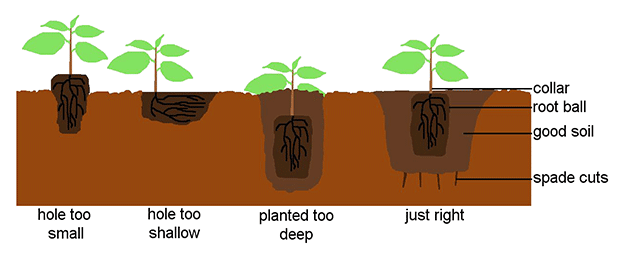The success of your planting project will depend on good site preparation and planning. It’s important that your new plantings can grow without competition from weeds and that they are protected from pests. Find out when to plant and how to prepare the ground. Check out our tips for planting and follow-up care.
Prepare a planting plan
Prepare your planting plan well before you intend to plant. This gives you plenty of time to grow or source the plants you need. What you plant will depend on your site and your goals. Find out more about planning your project.
When to plant
 Otatara School pupils do some planting.Planting time in Southland is less crucial than in other drier parts of New Zealand. However, severe frosts can be a problem in mid winter.
Otatara School pupils do some planting.Planting time in Southland is less crucial than in other drier parts of New Zealand. However, severe frosts can be a problem in mid winter.
Plant frost-hardy species in late autumn or spring (after severe frosts) while the soil is damp and cool. This allows them to establish their root system before the drying effects of summer. They are more likely to survive a dry spell in the following summer if they’ve had the previous winter and spring to establish. Avoid planting in mid winter when the damaging effects of severe frosts can take their toll.
Plant less frost-hardy species in early spring when frosts are less severe. They’ll still have time to establish before summer.
Put a layer of mulch around your trees to further protect them from drying out and increase their chance of survival.
Prepare the ground
 Marcie and Elke get planting!Permanently fence off your site from stock.
Marcie and Elke get planting!Permanently fence off your site from stock.
Prepare your planting site well in advance. It’s important that your new plantings can grow without competition from weeds. Weeds can rob your plants of light, soil nutrients and water if they are not controlled.
Using herbicides to clear areas of grass and control weeds is often the quickest and easiest method. Make sure to carefully follow label instructions and avoid spray drift onto non-target plants.
If spraying individual planting sites, spray about one square metre. This gives your planting enough clear space around it to establish. Be careful not to over-clear your planting area. You’ll increase the amount of future work to keep the space clear and your plantings will become more attractive to animal pests like rabbits.
Planting
Set our your plants according to your planting plan. When planting colonising species, allow one plant per square metre.
When planting plants that have been grown in containers (such as pots, root trainers or bags), remember to:
- Make the planting hole at least twice the size of the container – this gives the roots plenty of room to establish in fresh soil.
- Cover the roots with soil, but ensure the root ball is no more than 3cm below the soil surface.
- Use weed mat or mulch around the base of the plant (helps to suppress weeds and retain moisture).
- Protect your plantings from rabbits!
 How best to place your plant in the ground.
How best to place your plant in the ground.
Adding a slow release fertiliser when planting is beneficial but not essential.
Most plants should not require staking when planting. However, stakes are useful for locating plants in the future.
Follow-up
When grass and weeds grow too close to your plantings they will rob them of light, nutrients and water. In areas where weeds and invading grass are a problem you will have to follow-up your planting with ‘releasing’. ‘Releasing’ involves clearing the area immediately around your plantings of grass and weeds.
Fast growing species may only need to be released for the first year after planting. However, slower growing species may need releasing for up to three years, before they really establish.
You can release your plantings by hand-pulling neighbouring vegetation. However, this is time consuming and laborious. Herbicides are better for larger projects. They are cost effective and large areas can be treated relatively quickly. Use a knapsack sprayer to get more even control of the spray. Spray in a ‘Z’ pattern so you don’t concentrate herbicide in a circle around your plant (which you don’t want to kill!)
Animal control
Protect your plantings from pest animals while they are establishing. Rabbits in particular can be a problem.
A cost effective way to protect your plants from rabbits is to use protective covers or netting on wires. Spraying repellent onto plants has limited value in Southland as we have high levels of rainfall. If you prefer to use poison, then Pindone is the only poison available to the general public for rabbit control.
Pindone is incorporated into a cereal-based pellet which has proved highly acceptable to wild rabbits. When used within a bait station, no licence is required for Pindone pellets. It is the most commonly used rabbit poison in Southland. Pindone and bait stations can be purchased from stock and station agents. Pindone pellets are available in 2kg, 10kg and 25kg bags. Only enough Pindone to complete the job should be purchased as the product has a shelf life of 6-8 months.
Find out more
Contact us to find out more.
